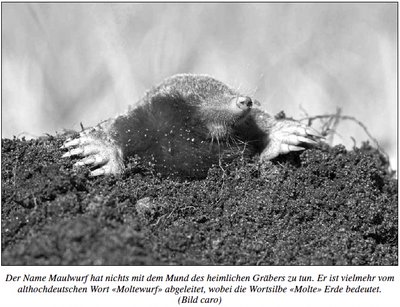The tunnel-driver
The tunnel-driver

The little volcanic craters, which show out of the soil, reveal the mole’s attendance. This intriguing digger feels comfortable where the soil is healthy and fertile.
The tunnel-boring machine at the Gotthard was more than 400 metres long and weighed 2,700 tons. The mole in our meadows and woods is 10 to 17 centimetres long and weighs 60 to 120 grammes. Nevertheless, it wins the race: The tunnel-boring machine needs an hour per metre – in the best case 1.6 metres – the mole makes seven metres in the same time. Of course, the stone at the Gotthard is harder, but that shall not diminish the small digger’s performance.
Moles are droll powerhouses. Potent muscles connect both arm-bones and shoulder girdle with the body. This vests an extraordinary arm bar in it. The forepaws are real excavator shovel – an extra- “thumb”, consisting of sickle-shaped bones – additionally extends the digging surface. The cylindrical body pushes itself like a digger through the soil. The spoil regularly is disposed of. Moles are able to move soil weighing 24 times as much as itself. A welcome side effect of the digging is the optimising of the aeration and loosening of the soil.
A helpful hunter
The volcano-shaped spoil hills are the only visible evidences of the presence of moles. However, they are the reason for the bad record of this helpful animal. They especially drive devotees of sterile (“English”) lawn to desperation. Farmers bewail the soil hills within the grassland that dirt hay and silage and damage the mowers’ blades. Although the mole’s digging activity loosens and aerates the soil, also voles can inhabit it. Hence, it is not very popular in vegetable gardening and fruit cultivation, as well.
Different from the voles the mole never feeds on roots or tubers. This black companion is not a rodent. It lives on nothing but animalistic food, especially on insects and earthworms; accordingly the presence of the mole shows healthy and fertile soil. The mole not only regulates the population of the earthworms, but also that of cockchafer grubs, wireworms, weevils, and snails that lead to harvest losses.
The extended burrow-system serves the mole as a trap. All three to four hours it patrols the whole burrow-system. There it collects the soil animals, which have entered its tunnel. One part of the preys the mole temporarily stores in its food store. A well-aimed bit paralyses insects and worms. In fertile soils, these pantries are well filled: in one single storage 1,200 earthworms and 18 cockchafer grubs were counted that weighed two kilo grammes!
Special features
The family of the moles includes 35 species in Eurasia and Northern America and is a biome of the superlative: the North American star-nosed mole is able to locate its prey optimally, because it is able to smell stereo. The same species has the most sensitive skin area within the entire realm of mammals: The star-shaped snout contains the highest density of nerve endings. The Swiss indigenous mole is a sensitive being, too: By means of different sensory organs, it is able to sense even slightest differences in pressure and air currents within the tunnel system. Even its tail is equipped with an extraordinary tactile sense – the mole uses it like a blind man’s stick. In order not to be poisoned by carbon dioxide, the moles’ blood contains eminently many red blood cells (haemoglobin). These convey the oxygen from the lung – which is particularly large in the mole – all over the body and reship carbon dioxide in the opposite direction. The silken fur is one of densest of the whole animal kingdom with 200 hairs per square millimetre. Neither soil nor water can permeate it. The hair is flexible towards any direction, which allows the mole to move forwards and backwards within the narrow tunnels. It reaches the speed of until four kilometres per hour inclusive. This race it also wins against the tunnel-boring machine. •
Contact: Dr Elena Havlicek, Federal Office for the Environment FOEN,
e-mail: elena.havlicec@bafu.admin.ch
Source: Federal Office for the Environment FOEN. <link http: www.boden2015.ch>www.boden2015.ch